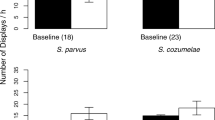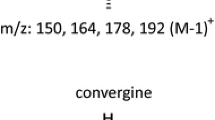Abstract
Theoretical treatments and empirical studies both suggest that signals that occur in multiple sensory modes have superior detectabilities, discriminabilities, and memorabilities. There is also an intuitive link between signal detectability, discriminability, and memorability and the quality of information that is transferred via the signaler. We investigated the role of information quality and sensory modality in the sexual identification of intruding conspecifics by territorial male red-backed salamanders (Plethodon cinereus). Our results imply that these salamanders are able to discriminate between intruding male and female conspecifics (based on the allocation of aggression) in bimodal scenarios (vision and olfaction) even under situations in which the information available about the intruders’ sexual identities is reduced in quality. In unimodal scenarios (olfaction only), male residents exhibited heightened levels of aggression toward male secretions and reduced levels of aggression toward female secretions. In unimodal scenarios where information pertaining to the sex of the stimulus was reduced in quality, male residents displayed intermediate levels of aggression relative to the responses that male and female stimuli received respectively. Although resident males touched bimodal stimuli significantly more than they touched unimodal stimuli, we were unable to find support for the notion that sensory modality greatly influences how male resident red-backed salamanders allocate aggression toward intruding male versus female stimuli.
Similar content being viewed by others
References
Abrams PA (1994) Should prey overestimate the risk of predation? Am Nat 144:317–328
Conant R, Collins JT (1998) A field guide to reptiles and amphibians, eastern and central North America, 3rd edn. Houghton Mifflin, New York
Dawley EM, Bass AH (1988) Organization of the vomeronasal organ in a plethodontid salamander. J Morphol 198:243–255
Dawley EM, Bass AH (1989) Chemical access to the vomeronasal organs of a plethodontid salamander. J Morphol 200:163–174
Funk DH, Tallamy DW (2000) Courtship role reversal and deceptive signals in the long-tailed dance fly, Rhamphomyia longicauda. Anim Behav 59:411–421
Gabor CR, Jaeger RG (1999) When salamanders misrepresent threat signals. Copeia 1999:1123–1126
Gillette JR, Peterson MG (2001) The benefits of transparency: candling as a simple method for determining sex in red-backed salamanders (Plethodon cinereus). Herpetol Rev 32:233–235
Gillette JR, Jaeger RG, Peterson MG (2000) Social monogamy in a territorial salamander. Anim Behav 59:1241–1250
Guilford T, Dawkins MS (1991) Receiver psychology and the evolution of animal signals. Anim Behav 42:1–14
Hughes M (1996) The function of concurrent signals: visual and chemical communication in snapping shrimp. Anim Behav 52:247–257
Hultsch H, Schleuss F, Todt D (1999) Auditory-visual stimulus pairing enhances perceptual learning in a songbird. Anim Behav 58:143–149
Jaeger RG (1980) Fluctuations in prey availability and food limitation for a terrestrial salamander. Oecologia 44:335–341
Jaeger RG (1984) Agonistic behavior of the red-backed salamander. Copeia 1984:309–314
Jaeger RG, Forester DC (1993) Social behavior of plethodontid salamanders. Herpetologica 49:163–175
Jaeger RG, Gabor CR (1993) Intraspecific chemical communication by a territorial salamander via the postcloacal gland. Copeia 1993:1171–1174
Jaeger RG, Schwarz JK (1991) Gradational threat postures by the red-backed salamander. J Herpetol 25:112–114
Jaeger RG, Goy JM, Tarver M, Marquez CE (1986) Salamander territoriality: pheromonal markers as advertisement by males. Anim Behav 34:860–864
Jaeger RG, Gillette JR, Cooper RC (2002) Sexual coercion in a territorial salamander: males punish socially polyandrous female partners. Anim Behav 63:871–877
Koops MA, Abrahams MV (1998) Life history and the fitness consequences of imperfect information. Evol Ecol 12:601–613
Lang C, Jaeger RG (2000) Defense of territories by male-female pairs in the red-backed salamander (Plethodon cinereus). Copeia 2000:169–177
Mathis A (1991) Territories of male and female terrestrial salamanders: costs, benefits, and intersexual spatial associations. Oecologia 86:433–440
McGavin M (1978) Recognition of conspecific odors by the salamander Plethodon cinereus. Copeia 1978:356–358
Moran MD (2003) Arguments for rejecting the sequential Bonferroni in ecological studies. Oikos 100:403–405
Nowak M (1990) Stochastic strategies in the prisoner’s dilemma. Theor Popul Biol 38:93–112
Petranka JW (1998) Salamanders of the United States and Canada. Smithsonian Institution, Washington, DC
Rice WR (1989) Analyzing tables of statistical tests. Evolution 43:223–225
Rollmann SM, Houck LD, Feldhoff RC (1999) Proteinaceous pheromone affecting female receptivity in a terrestrial salamander. Science 285:1907–1909
Rowe C (1999) Receiver psychology and the evolution of multicomponent signals. Anim Behav 58:921–931
Rowe C, Guilford T (1999) Novelty effects in a multimodal warning signal. Anim Behav 57:341–346
Siegel S, Castellan NJ Jr (1988) Nonparametric statistics for the behavioral sciences. McGraw-Hill, New York
Silva Nunes V da, Jaeger RG (1989) Salamander aggressiveness increases with length of territorial ownership. Copeia 1989:712–718
Silverstein AB (1978) Critical values for nonparametric multiple comparisons. Psychol Rev 43:44–46
Simons RR, Felgenhauer BE (1992) Identifying areas of chemical signal production in the red-backed salamander, Plethodon cinereus. Copeia 1992:776–781
Simons RR, Felgenhauer BE, Jaeger RG (1994) Salamander scent marks: site of production and their role in territorial defence. Anim Behav 48:97–103
Wise SE, Jaeger RG (1998) The influence of tail autotomy on agonistic behaviour in a territorial salamander. Anim Behav 55:1707–1716
Zar JH (1999) Biostatistical analysis, 4th edn. Prentice Hall, New Jersey
Acknowledgements
We thank Paul Klerks, Paul Leberg, and Susan Walls for providing helpful comments on an earlier draft of this paper. Discussions with M. Paige McMurry and David Marsh improved the content of this paper. Salamanders were collected under permit 017047 from the Virginia Department of Game and Inland Fisheries, and laboratory experiments were approved by the Animal Care and Use Committee of the University of Louisiana at Lafayette (IACUC no. 2002-8717-051). This research was funded by N.S.F grant IBN-0205804.
Author information
Authors and Affiliations
Corresponding author
Additional information
Communicated by H. Kokko
Rights and permissions
About this article
Cite this article
Page, R.B., Jaeger, R.G. Multimodal signals, imperfect information, and identification of sex in red-backed salamanders (Plethodon cinereus). Behav Ecol Sociobiol 56, 132–139 (2004). https://doi.org/10.1007/s00265-004-0774-9
Received:
Revised:
Accepted:
Published:
Issue Date:
DOI: https://doi.org/10.1007/s00265-004-0774-9




